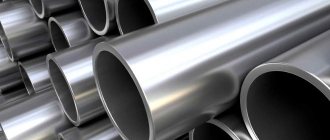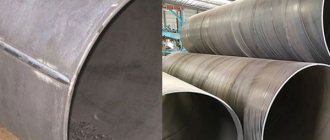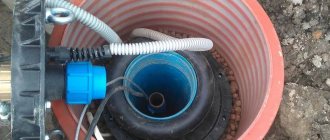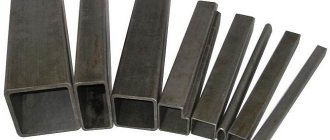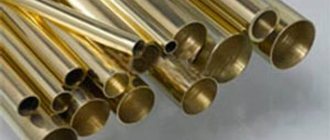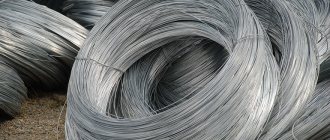SHARE ON SOCIAL NETWORKS
FacebookTwitterOkGoogle+PinterestVk
In our country, profile pipes have been produced for decades: sizes (standard and specified by the customer) are presented in a wide range. The manufacturing process for square-section products is more complex than the manufacturing technique for round pipes. Their cost is justified by the additional labor costs. The use of special equipment and painstaking work involving the use of the latest technologies is a guarantee of the quality of profiled products.
Profile pipes are produced in different sizes - standard and custom-made
Features of hot- and cold-deformed pipes
Pipes are hollow thin-walled and thick-walled metal rods of different formats. Judging by the volumes of production and purchases, round and square seamless products remain the most popular. Their consumption increases with the growth of the economy and the needs of the population. The product line is expanding, different sizes of square profile pipes are offered.
The weight, size and length of profile pipes are established by technical specifications
Profile pipes are closed profile products made from rolled steel. Domestic and foreign companies, improving production technologies, offer competitive products. The main dimensions of rectangular profile pipes (as well as square and oval) are listed in tables on the official websites of manufacturers. Deviations are negotiated by managers with a specific buyer.
Helpful advice! The dimensions of products, their weight and length, established in the technical specifications, must be checked for compliance with GOST standards specified in the table before purchasing a batch.
Profiled pipes undergo sheet metal molding according to specified parameters. The process consists of several stages and ends with the processing of products on a calibration mill and welding of the seam. The maximum dimensions of rectangular pipes are set initially, the standard is 12 m, short profiles are cut from 1 to 9 m. Enterprises produce products from available raw materials using special equipment, their range is limited by technical conditions (TU). The profile is made from carbon grades of alloyed and high-alloy (containing chromium, molybdenum, nickel, manganese) steel, resistant to corrosion and high temperatures. The brand must meet the following standards:
- hot-deformed electric-welded profile – 10ps, St4sp, St4ps, St4kp, St2sp, St2ps, St2kp, 10 and 20;
- hot and cold deformed profile – 10ps, 08kp, 10, 20, 35 and 45.
According to the production method, profile pipes can be cold- or hot-formed
Rolled profiles are produced according to specified parameters, including wall thickness, in accordance with GOST 1050-88 and 380-94. Their production uses mainly steel grades St2, St3, St10, St20.
Materials
A stainless steel profile pipe is part of the structure and is made from corrosion-resistant grades: AISI 304 and AISI 316, less commonly AISI 439, 430, 409. In this case, its service life increases. Simple zinc coating is possible. They are ideally used to form architectural elements and create load-bearing frames.
Profiled pipes of this type are not subject to abrasion and are resistant to elevated temperatures. They are distinguished by a variety of finishing processes through polishing, grinding, sandblasting and etching.
As an alternative, aluminum is used, which increases the service life of the pipe. Its flexibility helps to create complex shapes that are widely in demand in everyday life and industrial production.
Aluminum profile pipe with a significant external surface area and a reduced volume inside increases the demand in cooling systems with the greatest heat removal from the carrier in the form of a radiator or coil. They are used to produce equipment, cars, ships and aircraft. Among the advantages of aluminum products: low weight and range of work performed from -60°C to +180°C.
In fact, the importance of a closed profile can hardly be overestimated from the point of view of technological techniques and financial benefits. They are easy to use and are an indispensable material in the construction of any construction project.
Features of the production of profile metal pipes
According to the production method, profile pipes are either hot- or cold-formed. Due to the plasticity of metals, profiling of any steel workpiece is possible under the influence of high temperatures. On a cut (section) the pipes have the following shape:
- square;
- rectangle;
- oval
Flat-oval arched profiles (or oval pipes) are no less in demand, and their production is growing. The technology for forming them is practically no different from rolling standard professional pipes. This is like an intermediate option between round and rectangular structures, and their quality and endurance indicators are an order of magnitude higher than those of these products. The technology for producing standard pipe sizes involves:
The cross-section of the pipes has the shape of an oval, square or rectangle
- method of cold molding of rounded products using a press;
- welding rectangular steel sheets.
Important! The cost of rolled steel with a welded seam is lower than the price of solid pipes. There is no need to doubt their quality: the joint is checked with a flaw detector before receiving a certificate and an acceptance certificate.
In accordance with GOST, pipes of any size (in inches and mm) are formed using two technologies that differ significantly from each other:
- By welding a sheet or strip profile (the seam can reduce the quality of the product only under significant loads, and the product has a lower price).
- Rounded rods are pressed into blanks of the same shape at a rolling mill (the technology is more expensive; seamless products bear the maximum load in vertical frames).
Pipes are produced by cold forming rounded products using a press and welding rectangular sheets
Kinds
According to the cross-sectional profile, pipes are divided into: square, rectangular, oval and flat-oval. The latter option is in demand in the furniture industry. Resembling round in physical characteristics, they are extremely decorative.
They are used to create pieces of furniture, fencing parts and elegant building elements. The oval profile is invariably flexible across the long side, belonging to the arched type.
Other structures are known as reinforcing components or independent products. Based on the characteristics of their production, they are divided into: welded, seamless, hot-rolled and cold-rolled. The seamless construction has no seams due to the use of a solid cylinder-shaped piece called a “rod”.
Multifunctionality and main parameters of pipes with stiffeners
During the technological formation of a steel pipe, the dimensions correspond to the given length, and during rolling the shape is given as rectangular (square) with 4 stiffeners. The output is a pipe profile. Its configuration stands out among ordinary round pipes. Products made from cold-deformed steel do not differ significantly in cost from other varieties. Using cold technology, an aluminum or galvanized profile is produced, which is additionally given anti-corrosion properties.
Helpful advice! It is recommended that before purchasing, look at the prices for finished products in the price lists, taking into account the obvious savings and the cost of delivery to your region.
The increased demand for aluminum profiles is justified by technical parameters:
- resistance to physical impact;
- low weight with significant dimensions of metal pipes;
- increased strength with sufficient ductility of the metal;
- minor deviations due to deformations;
- wide range of applications;
- affordable prices for the entire aluminum and galvanized range, taking into account pipe sizes.
When rolled, profile pipes are given the shape of a rectangle with four stiffeners
In the Russian Federation, more than 400 enterprises specialize in the production of profiled and round steel pipes. They differ in the range of cross-sections and wall thicknesses, their applications are almost limitless.
Profile pipe: dimensions according to GOST, section shape
All metal assembly and installation components used in any field must comply with the following standards:
- GOST 8639-82 – square profile;
- GOST 8645-68 – rectangular profile;
- GOST 8642-68 – arched or oval profile.
Table of steel pipe sizes according to GOST:
| Types of pipe lengths | Length, m | Type of pipe rolling |
| Measured length | 4,5-11,0 | Used cold-formed |
| 4,0-12,5 | Used hot-formed | |
| 5,0-9,0 | Electric welded products | |
| Unmeasured length | 1,5-9,0 | Used cold-deformed or electric welded |
| 4,0-12,5 | Used hot-formed | |
| Multiple lengths with 5 mm cut allowance | 1,5-11,0 | Used cold-formed |
| 4,0-12,5 | Used hot-formed |
According to GOST, as well as in accordance with tables of sizes of profiled pipes, enterprises offer the following products:
- steel pipe profile of rectangular section with dimensions from 15x10 to 180x150 mm with a metal wall thickness of 1-12 mm (special sizes - products from 28x25 to 230x170 mm with a wall thickness of 1.5 to 20 mm);
- square profile with edge from 10 to 180 mm, wall thickness - from 1 to 14 mm (special sizes - blanks from 32 to 65 mm, thickness from 4 to 6 mm);
- steel round-oval profile, having a format from 6x3 to 90x50 mm and a wall thickness from 0.5 to 2.5 mm (special sizes - blanks from 17x6.6 to 72x22 mm, wall thickness - from 1 to 1.7 mm).
The development of industry and agriculture, oil production and construction sectors leads to an expansion of the range of shaped profiles. The production of pipes with a polyhedron cross-section, bent products and thick-walled supports with an outer diameter of up to 2520 mm (wall up to 75 mm) has been launched.
Square profile pipes must comply with GOST 8639-82 standards
Attention! Enterprises are expanding the production of new forms of pipes, channels, beams and corner profiles. Before purchasing, it is important to clarify the assortment; an individual order is also possible.
Features of manufacturing profile pipes of various sizes
Profile pipes are made from round pipes. The dimensions of profile pipes are determined depending on the upcoming load.
This work is carried out as follows: a product with the required diameter is used as a blank - the desired shape is given by mechanical deformation - hot or cold. Reliability of fastening is ensured by the welded seam of the pipe blank, which, as a rule, is achieved through special processing.
There are two ways to make a square profile pipe:
- Using special rolls, finished pipes with a round cross-section are compressed from all sides - a square profile pipe is obtained, the dimensions of which vary according to the diameter of the workpiece.
- The metal sheet is cut into blanks, then box-shaped sections are created and fixed using a seam.
Production of profile pipes
Profile pipe used in construction: dimensions, tables
Each type of pipe, beam and profile is designed for specific purposes. Products with an average wall thickness of 8 to 12 mm are suitable for construction. In the manufacture of such rolled metal, billets made of steel grade St3sp/ps5, produced in accordance with GOST 14637-89, are used. High-strength metal 09G2S is also used (this is a profile in accordance with GOST 19281-89).
The most popular are professional pipes - universal rolled metal with stiffeners. They are used for construction:
- sports and children's playgrounds;
- sports complexes and swimming pools;
- fences and fencing;
- frame-type metal structures;
- canopies for all kinds of purposes;
- billboards and billboards;
- flagpoles and towers;
- public transport stops, etc.
Pipes with an average wall thickness of 8 to 12 mm are used in construction
Each object requires a specific profile. According to standardization, products are classified according to their cross-sectional shape as “rectangle”, “square”, “oval” and “polygon”.
Standard pipe sizes in inches and millimeters, table
Products with a rectangular cross-section meet the following parameters:
- technical requirements - GOST 13663-86;
- weight 1 linear m – from 0.348 to 55.71 kg;
- cross-section – from 15x10 to 180x150 mm;
- pipe wall thickness – from 0.8 to 12.0 mm.
Square profile:
Rectangular profile pipes have a standard cross-section ranging from 15x10 to 180x150 mm
- technical requirements - GOST 8639-82;
- weight 1 linear m – from 0.22 to 70.33 kg;
- cross-section – from 10x10 to 180x180 mm;
- The wall thickness of the steel pipe is from 0.8 to 14 mm.
Arched profile (oval pipes):
- technical standard - GOST 8642-68;
- weight 1 linear m – from 0.513 to 38.7 kg;
- cross-section – from 6x3 to 72x22 mm;
- wall thickness – from 0.5 to 2.5 mm.
This table will introduce the standard sizes and weights of steel pipes:
| Cut shape | Section, mm | Wall, mm | Weight, kg |
| Rectangle | from 10x15 to 1502x180 | from 0.8 to 12.0 | from 0.348 to 55.71 |
| Square | from 10x10 to 180x180 | from 0.8 to 14.0 | from 0.22 to 70.33 |
| Ellipse (oval) | from 6x3 to 72x22 | from 0.5 to 2.5 | from 0.0513 to 3.87 |
The following designations may appear in technical documentation:
- GOST – state standard for pipes used in gas, oil and heat pipelines;
- DIN/EN – European range of steel pipes in accordance with DIN 2448 and DIN 2458;
- ISO – standard for diameters of plumbing and engineering systems;
- SMS – Swedish standard for pipe diameters and valves;
- DN (Dy) – nominal diameter.
If the product size presented in millimeters is required to be converted to inches, the value is rounded up. There are 25.4 mm in 1 inch, which gives a rounding error that is taken into account when purchasing.
Table of pipe diameters in inches and millimeters:
| Pipe diameter, inches | Pipe diameter, mm |
| 1/2 | 15 |
| 3/4 | 20 |
| 1 | 25 |
| 1+1/4 | 32 |
| 1+1/2 | 40 |
| 2 | 50 |
| 2+1/2 | 70 |
| 3 | 80 |
| 4 | 100 |
Advantages and disadvantages of profile rolled products
Compared to round pipes of similar sizes, profile pipes have a number of advantages:
- Increased bending resistance.
- Less weight and metal consumption.
- Simplicity of connecting pipes to each other, with frame sheathing and other parts using welding or bolted connections, which simplifies installation and assembly work.
- Good appearance.
- A variety of materials used in production.
In addition, the equipment on which they are produced has high productivity and a degree of automation, which allows reducing the cost of these products.
The disadvantage is the difficulty of using them as pipelines and gas pipelines for the following reasons:
- The pressure of liquids and gases on the walls of the profiles causes increased deformation compared to round pipes.
- All commercially produced connecting and shut-off pipeline fittings - couplings, valves, gate valves, valves, etc. Designed for use with round pipes.
- To bend profiles, special pipe benders are required.
- Higher cost.
What are the sizes of profile pipes, types of rolled products processing?
The most popular sizes are the following (measured lengths up to 12 m and in multiple lengths):
- square pipes – cross-section from 15x15 to 60x60 mm;
- rectangular profile - section from 15x20 to 44x80 mm.
Profile steel pipes (dimensions are regulated by GOST) according to the processing method are mainly divided into the following types:
The most popular cross-sectional dimensions of a rectangular pipe are from 15x20 to 44x80 mm
- seamless cold-deformed (cold-drawn and cold-rolled);
- hot-deformed seamless steel pipes (hot-rolled, hot-pressed and hot-forged);
- hot-deformed welded (straight-seam, spiral-seam);
- seamless (centrifugally cast, heat-rolled and heat-drawn) products;
Related article:
Diameters of steel pipes: how to properly plan communications
Why do you need to know the diameter of the pipe? Varieties of these parameters. Units of measurement: inches and millimeters. Steel pipe diameter tables.
- straight-seam (electric welded and welded);
- rolled, soldered and furnace welded pipes;
- cold-deformed (drawn and rolled);
- surface-treated steel pipes;
- processed (polished and ground) products with metal and non-metallic coating;
- nickel plated and with anti-corrosion coating.
Helpful advice! It is recommended to check the length of the products (including the profile pipe), dimensions and weight in the tables.
The following basic parameters of the profile pipe are known:
According to the processing method, profile pipes can be seamless or welded
- profile type (geometric shape on a cut);
- grade of steel or other metal;
- pipe length;
- cross-section diameter (pipe sizes in inches and millimeters);
- wall thickness;
- presence of a seam;
- the presence of additional processing: galvanizing, grinding, polishing, etc.
Pipes are produced with machined cuts, with threads on one or both ends and a different type of end finishing:
- tapered and flared metal rods;
- bearing steel pipes;
- products with upset ends and other types of processing.
In addition to rectangular and square structures, according to GOST, pipe sizes and their shape can vary within the following limits:
- drop-shaped and polygonal rolled products;
- oval and flat oval steel profile.
Seamless pipes can be heat-drawn, heat-rolled or centrifugally cast
Important! In difficult operating conditions (at high temperatures), a high-pressure profile is used, which is also hardened.
Construction needs: profile pipes, wall dimensions
Currently, the most popular are furniture and construction profiles. Rectangular and square pipes are produced in accordance with GOST 30245-2003 standards. It is difficult to imagine industrial, military and civil construction without them. These products are used for the manufacture of the following structures:
- frame type buildings;
- stairs and steps;
- floors;
- sheds and farms;
- racks and supports;
- bridge columns;
- railway spans;
- warehouses and complexes in the field of logistics.
Helpful advice! You should not rush to order a large batch of products without clarification. It is recommended to first find out all the parameters of the professional pipe in order to determine its suitability for specific tasks.
The oval profile is widely used not only in construction, but also in furniture production
Furniture blanks are nickel-plated or polished, oval or square profile. Most often they are formed from steel strips with a thickness of no more than 1.5 mm. This is due to the need for lightweight structures. Such parts are not designed for increased load; they are subject to destructive mechanical effects. As a rule, furniture blanks are thin-walled products of short length:
- square-section parts with dimensions from 10x10 to 30x30 mm;
- rectangular elements - from 20x10 to 40x25 mm;
- blanks of oval and flat-oval type within the 10x20 mm format.
Furniture profiled pipe products are produced in accordance with the specifications of enterprises, for example, TU 14-105-737-2004, as well as in accordance with the previously listed GOST standards. High demands are placed on the quality of surface treatment and pipe geometry. Oval and flat-oval profiles are aesthetically pleasing and smaller in size. The price per meter of profile pipes used for furniture production will be an order of magnitude higher than the cost of other types of pipe products.
Classification of profile pipes by manufacturing method
Although shaped pipes may look similar in appearance, there are four different ways to achieve this configuration. The strength of the product and the cost, as well as the possible maximum dimensions and features of further operation, depend on the production methods.
Seamless hot-formed
Blanks for production by hot deformation are obtained by rolling, continuous casting or forging. To produce seamless profile hot-rolled pipes, a round cross-section pipe that does not have a weld is used. Next, the part is subjected to heating and mechanical stress on a longitudinal press.
A roller system is used to achieve the final shape. This produces a profile of the required size and correct cross-section. In this way, a square or rectangular pipe with thick walls is produced, characterized by increased strength to withstand loads.
Seamless profile pipe.
Seamless cold rolled
To obtain profile products using this method, the same blanks are used without seams as in the method described above. The difference is that the round sleeve does not heat up, but rather cools and only then enters the roller system to form the profile.
In this way, profile pipes with thin walls are produced. The deviation from standard dimensions does not exceed 0.5%, therefore seamless cold-rolled pipes are actively used in shipbuilding, car manufacturing, and various equipment where the accuracy of parameters is important.
Cold-deformed welded pipes
Pipes are produced from steel strips (strips) wound into a roll. Using special equipment, it is unwound and bent longitudinally into a cylinder. The result is a round pipe with a longitudinal side joint. The joint is connected by semi-automatic, resistance or plasma welding.
Strips.
Next, the sleeve is fed to a conveyor with rollers that exert a force of hundreds of tons on it. This gives the product a profile shape. In this case, internal stresses inevitably arise in the metal due to deformations. To “release” them, heat is used. This eliminates possible subsequent physical processes and ensures that the correct, permanent shape of the steel is maintained.
Welded profile pipe.
Welded steel strip pipes
This type of profile pipe production is used to produce products with a small cross-section. Steel sheets are used as the starting material here. First, a strip is made on a guillotine - a pipe blank. Then the strip is subjected to deformation, and the joint is fastened with spot or arc welding.
This method produces profile pipes with thin walls. The product has precise dimensions. When using galvanized steel sheets with an even smaller cross-section, it is possible to produce complex pipe structures of non-standard configurations.
Comparison of methods for producing profile pipes
All profile pipes are inferior in cost to their round counterparts, since they are produced from cylindrical blanks (essentially, ready-made round pipes), and only then become square or rectangular due to processing by rollers.
Round pipes also distribute internal pressure better, because it spreads evenly over the area of the walls. But square and rectangular sections are more convenient when assembling and welding metal structures (easier to join, more convenient to cut, does not roll on a flat surface, etc.), so profile pipes are in great demand.
1. The first two manufacturing methods are considered the most expensive. Because of this, they are rarely used and are justified only for obtaining products intended for places with high loads. These may be support columns and other structural elements on which safety depends.
But where a high-strength profile is applicable, seamless round analogues are also suitable. If you want to save money, you can use non-profiled pipes.
2. The method of producing a profile pipe from strip is the cheapest, due to the low cost of the workpieces. Another advantage of the technology is its unlimited size. A steel strip in a coil can be 10 meters or more in length, so the final profile size has no restrictions.
This makes it possible to produce a single pipe of large longitudinal dimensions, saves time when assembling structures, and eliminates the need to weld additional sections on site.
To summarize: for areas with high loads it is better to use seamless profile pipes, and for normal use profile products made from steel strip are suitable.
3. Be careful when choosing a manufacturer . Note that it is possible to produce a profile pipe from single-seam cylindrical blanks not only at the factory, but also in a garage or small workshop. To do this you will need a machine with rollers. To reduce costs, some entrepreneurs do not waste electricity to inductively heat the metal and relieve residual stress.
This is not critical if the products are used for the manufacture of fences, furniture, and small metal structures. But such pipes are not suitable for construction, since they can subsequently become deformed. In this case, before purchasing, you should clarify the nuances of making the pipe or simply contact a well-known manufacturer with a good reputation.
Profile pipe: dimensions and prices, purpose and functionality
Square pipes are used in various industries, including the production and installation of metal structures for external and internal use. There are no special requirements for them in terms of surface quality. The general purpose profile is produced on the basis of hot-rolled steel strips, the thickness varies between 1.5-5 mm. According to functional features or conditions of use, products are classified into the following types:
The cost of a rectangular profile starts from 51.5 thousand rubles per 1 ton
- metal profiles for general and special purposes;
- products for oil production, gas transportation and geological exploration;
- drilling and casing equipment;
- compressor and pumping equipment;
- water pipes;
- heat-resistant steel products for boiler rooms;
- chemical equipment;
- major highways;
- steel supports with stiffeners for construction;
- durable, multi-purpose products.
Important! In order to improve the quality or reduce the cost of products, at the request of the customer, it is possible to vary the technology and change the grade of steel.
The use of rolled steel is widespread in mechanical engineering and construction, agriculture, communication systems and oil refining. All parameters, including pipe length and wall thickness, are regulated by GOST 13663-86.
The profile for general use is available with wall thicknesses ranging from 1.5-5 mm
Prices for pipe products:
- Square profile – from 52 thousand rubles/1 t and from 22 rubles. for 1 linear m.
- Rectangular profile – from 51.5 thousand rubles/1 t and from 26 rubles. for 1 linear m.
The length of pipe sections, depending on the purpose, varies from 1 to 12 m.
Properties of steel profiles for furniture production
The design properties of oval and square profiles were evaluated in the production of furniture. They were used as frames and legs, bases for folding beds and mechanisms for transforming sofas. Profiles are also used as auxiliary elements for forging and its imitation, as well as decorative fragments. The main functions of profiled metal products are loads and aesthetics.
Square and oval profiles are widely used in furniture production
In accordance with the specific application, the products are classified into 36 standard sizes. Furniture pipes have a small format:
- products of rectangular cross-section vary from 20x10 to 40x25 mm;
- square profile parts have a size of no more than 30x30 mm.
Helpful advice! In addition to ordinary pipes, bent blanks are also widely used, which are recommended to be ordered directly from the manufacturer. The plasticity of the metal makes it possible to bend a steel pipe (any size) at the required angle, forming arched and other complex structures.
Table of sizes of profile steel pipes of measured and unmeasured lengths:
| Type of pipe rolling | Diameter, mm | Wall thickness, mm |
| Electric welding molding | 10-100 | 1-5 |
| Hot deformation | 60-180 | 4-14 |
| Cold deformation | 10-120 | 1-8 |
Areas of application
Profile pipes are widely used for the manufacture of various structures:
- frames of buildings, warehouses, light production modules, trade kiosks and pavilions, livestock farms, scaffolding, sports facilities, children's and playgrounds;
- parts of industrial and instrument equipment in mechanical engineering, aviation, shipbuilding, nuclear and other types of industry;
- shelving, office equipment and furniture;
- gates and metal doors, street structures - fencing, fences, public transport stops, billboards, banners, etc.
When choosing a brand of profiled steel, you need to strive for the optimal combination of its properties, characteristics and cost in relation to the conditions of use.
Seamless cold and hot rolled pipes have the greatest mechanical strength. Their main disadvantage is the highest cost.
Cold rolled pipes have a number of advantages compared to other types of rolled products:
- highest dimensional accuracy;
- greatest linearity along the length;
- lowest surface roughness;
- high corrosion resistance.
Thin-walled rolled products obtained by rolling out finished round pipes are used mainly in furniture production, office decoration and various decorative structures, where good appearance is valued and great strength is not required.
Plastic pipes, due to their high insulating properties, are used as cable channels for laying electrical wiring, ducts in ventilation systems, in the production of windows and furniture.
The most common types of profiles are pipes made from steel strip by welding and cold rolling; they are used in all branches of production and construction.
Their strength reaches 90–95% of the strength of seamless pipes.
Advantages: a very wide range, durability, low cost.



